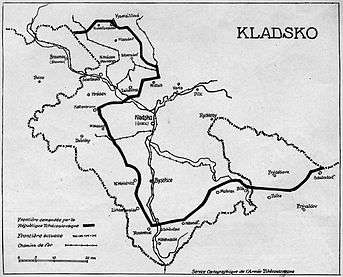Kłodzko Land


Kłodzko Land (Czech: Kladsko; German: Glatzer Land; Polish: ziemia kłodzka) is a historical region in southwestern Poland, which belongs to this country since 1945. Geographically speaking, Kłodzko Land (with an approximate area 1,640 km2)[1] consists of the Kłodzko Valley surrounded by parts of the Sudetes mountains, which together forms a significant jut into neighbouring Czech area. The land, named after its capital city of Kłodzko, today forms Kłodzko County of the Lower Silesian Voivodeship.
History
Historically, the area may have been part of Great Moravia under King Svatopluk I by the late 9th century, though the extent of his realm is disputed. According to the Chronica Boëmorum (1125) by Cosmas of Prague, the castle of Kłodzko on the road from Prague to Wrocław in 981 was a possession of the Bohemian nobleman Slavník.
During the rivalry between the Přemyslid dukes Boleslaus III and Jaromir in 1003, the Polish duke Bolesław I the Brave invaded Bohemia, but had to pull back the next year, facing the forces of King Henry II of Germany. In turn the Bohemian duke Bretislaus I campaigned the adjacent northern territory of Silesia in 1039. An armistice mediated by Emperor Henry II demarcated the spheres of influence, leaving Kłodzko with Bohemia.
When about 1080 the Polish Piast duke Władysław I Herman married Judith Přemyslovna, daughter of Duke Vratislaus II of Bohemia, he received Kłodzko as a Bohemian fief, which upon his death in 1102 was claimed by his son Duke Bolesław III Wrymouth of Poland. However as Bolesław became entangled in a fierce inheritance conflict with Duke Svatopluk of Bohemia and his cousin Borivoj II and campaigned in the Bohemian lands several times, he finally had to renounce Kłodzko in favour of Duke Soběslav I of Bohemia in a peace treaty signed in 1137 under pressure from Emperor Lothair III.
Under Bohemian rule Kłodzko, in 1458, became a county. In 1742 it was conquered by the Prussia. In 1818 the county was abolished, and the territory was reformed into the Landkreis Glatz of Prussian Silesia, which fell to Poland after the end of WW II (1945) as a part of the so-called Recovered Territories.
Czech claims
From the traditional Czech perspective, Kladsko was culturally and traditionally a part of Bohemia, although the region has now been a part of Lower Silesia since its conquest by the Kingdom of Prussia in 1763. Referred to as "Little Prague" (German: Klein-Prag), the Kłodzko Valley region on the Nysa Kłodzka river was the focus of several attempts to reincorporate the area into Czechoslovakia, one of several Polish–Czechoslovak border conflicts.[2] The last attempt occurred in May 1945 when Czechoslovakia tried to annex the area on behalf of the Czech minority present in the western part of the Kłodzko Valley and known as the "Czech Corner". Pressure brought on by the Soviet Union led to a ceasing of military operations, with the Czech minority being expelled to Germany and Czechoslovakia. According to canon law of the Roman Catholic Church however, the area remained part of the Roman Catholic Archdiocese of Prague until 1972.
- Proposals by the Czechoslovak Delegation on incorporating Kłodzko Land into Czechoslovakia during the Paris Peace Conference, 1919
 The maximalist variant
The maximalist variant The intermediate variant
The intermediate variant The minimalist variant
The minimalist variant
See also
References
- ↑ Semotanová, Eva; Felcman, Ondřej (2005). Kladsko. Proměny středoevropského regionu : historický atlas [Kladsko Region. The Transformations of the Central European Region : A Historical Atlas] (in Czech). Hradec Králové; Prague: Univerzita Hradec Králové; Historický ústav AV ČR. p. 15. ISBN 80-7286-066-6.
- ↑ http://ioh.pl/artykuly/pokaz/konflikt-graniczny-polskoczechosowacki-w-latach,1076/